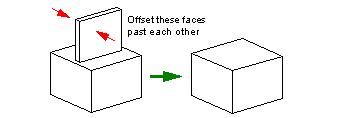 |
Local Operations |
| <<< Sectioning | Chapters | Local Ops: Spinning or Sweeping an Entity >>> |
Topology change is required when an operation would otherwise leave the model in an invalid state. The following functions, since they rely on a common algorithm, can perform a wide range of topology changes:
The following section attempts to describe the various broad classes of topology changes:
A multi-edge vertex can be split, and a new edge introduced into the model.

Figure 12-1 Offset body where the four-edge vertex has been split into two vertices connected by an edge
A face may become self-intersecting in the sense that its edges cross. Repair often involves the removal of faces, e.g. Figure 12-2.

Figure 12-2 Repair of body with self intersecting faces
The operation causes faces to clash into each other. This condition typically is accompanied by one or more self-intersecting faces, as described previously. Often the repair involves the removal of faces.

Figure 12-3 Tapering the cylindrical face outwards with the bottom edge fixed

Figure 12-4 Removal of clashing faces
The operation can cause faces to drift past each other. Repair involves the removal of faces or features, see Figure 12-5.

Figure 12-5 Repairing mirrored faces by removing the offending entities
This section describes some topology changes specific to the operation.
If the offset distance is greater than the minimum radius of curvature of surface, then that surface becomes either wholly inside-out or self-intersecting. In the former case Parasolid simply deletes the face. For example blends whose radius is less than the offset distance are removed from the model, see Figure 12-6.

Figure 12-6 Hollowed body where the blend around the top face is not present in the interior shell
In the later case, the situation is more complicated.

Figure 12-7 New edges replace the self intersections
Open sheet body with degeneracy.

Figure 12-8 This conical sheet body changes topology when offset
Often, tapering a cylindrical or conical face requires the kind of topology change illustrated in Figure 12-9.

Figure 12-9 Topology changes resulting from tapering operation
The rules for the persistence of tags described in Section 2.2.2, "Tags", apply during local operations. However, tag persistence is disabled if normal attribute callbacks are registered and used. See Section 46.3, "Callback functions" for more information.
| <<< Sectioning | Chapters | Local Ops: Spinning or Sweeping an Entity >>> |